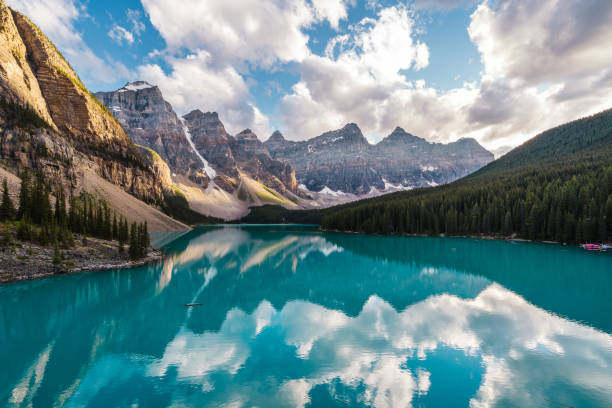The Canadian Rocky Mountain Parks World Heritage Site: A Majestic Testament to Earth's Natural Grandeur
Spanning across two Canadian provinces, nestled within the towering peaks and lush valleys of the Rocky Mountains, lies one of the most majestic and ecologically diverse regions on Earth—the Canadian Rocky Mountain Parks World Heritage Site. This globally recognized treasure is not a single park but an extraordinary amalgamation of seven contiguous parks: four national parks—Banff, Jasper, Yoho, and Kootenay—and three British Columbia provincial parks—Mount Robson, Mount Assiniboine, and Hamber. Together, they form an expansive, protected wilderness encompassing over 23,000 square kilometers of some of the most stunning alpine landscapes in North America. Declared a UNESCO World Heritage Site in 1984, with extensions in 1990, this vast stretch of mountainous beauty exemplifies the kind of pristine wilderness that has captured human imagination for generations and continues to be a living classroom for science, conservation, and outdoor adventure.

The roots of this iconic landscape reach back more than 600 million years, when the Earth's tectonic forces began shaping a mountainous spine across the continent. Over millions of years, the movements of ice, water, and geological uplift carved the serrated ridgelines, deep valleys, and dramatic escarpments that now define the Canadian Rockies. The result is a geography so complex and ancient that it continues to intrigue geologists and environmental scientists alike. Within the Canadian Rocky Mountain Parks, the geological phenomena are extraordinarily diverse—ranging from towering peaks such as Mount Robson, which rises to 3,954 meters, to glacially-carved valleys and turquoise lakes created by millennia of erosion and sedimentation. One of the world's most significant fossil fields, the Burgess Shale, is located here and offers a rare window into early marine life during the Cambrian Explosion over 500 million years ago. These fossil beds, particularly found in Yoho National Park, are so vital to the understanding of life’s evolutionary past that they were a major reason for the site's inscription into UNESCO's prestigious list.

However, the Canadian Rocky Mountain Parks are far more than just a spectacle of physical geography. They embody a delicate and vast ecosystem teeming with biodiversity. The mix of montane, subalpine, and alpine ecological zones creates diverse habitats that support a wide array of flora and fauna. Grizzly bears, black bears, wolves, mountain goats, elk, and moose roam the expansive wilderness, while cougars and lynxes prowl the dense forests. Birdwatchers find paradise here as well, with bald eagles, peregrine falcons, and a range of waterfowl inhabiting the wetlands and river valleys. The seasonal migrations of wildlife, combined with the unpredictable weather patterns and snow-covered winters, offer compelling dynamics for ecological study and wildlife observation.
Vegetation within the parks is equally diverse. The lower montane zones are covered with lodgepole pine and Douglas fir, while higher elevations support Engelmann spruce and subalpine fir. As one ascends further, the trees give way to tundra-like conditions with wildflowers and lichens clinging to rocky outcrops. The region’s flora, shaped by the harsh climate and unique soils, plays a vital role in maintaining the ecological balance and is a testament to nature’s adaptability.

The presence of glaciers is one of the most defining characteristics of the Canadian Rocky Mountain Parks. Glaciers, such as those found on the Columbia Icefield—one of the largest icefields in North America—are not only a dramatic feature of the landscape but also an important hydrological source for the continent. Rivers like the Athabasca, North Saskatchewan, and Columbia all find their origin in the melting snow and ice of these high-altitude fields. These waters, traveling thousands of kilometers, support ecosystems, agriculture, and human settlements far downstream, making the parks critical in a broader environmental context.
Historically, these lands have not always been pristine and untouched, as is sometimes mistakenly imagined. Long before European explorers arrived in the area in the 18th and 19th centuries, Indigenous peoples had called these mountains home for thousands of years. The Stoney Nakoda, Ktunaxa, Secwepemc, and other First Nations developed rich cultures deeply intertwined with the land. They used the valleys for seasonal hunting, followed game trails, fished in glacier-fed rivers, and lived harmoniously within the rhythms of nature. Many of the current trails in these parks trace their origins back to Indigenous travel routes, and the stories, spiritual beliefs, and land stewardship practices of these communities continue to influence contemporary conservation efforts. Recognition of this legacy is increasingly shaping how these protected areas are managed, with collaborative partnerships that aim to blend traditional knowledge with scientific research.
European interest in the region intensified during the mid-1800s when surveyors and explorers, searching for viable transportation routes and natural resources, began mapping the vast terrain. The completion of the Canadian Pacific Railway in 1885 through Kicking Horse Pass in Yoho National Park marked a pivotal moment in the region's history, bringing settlers, industry, and eventually, tourism. Recognizing the need to protect these majestic landscapes from rampant exploitation, Banff National Park was established in the same year, making it Canada’s first national park and the third in the world. This decision laid the foundation for a broader conservation ethic that would later culminate in the creation of the contiguous network of parks that now form the World Heritage Site.

Tourism played, and continues to play, a significant role in the development and international recognition of the Canadian Rockies. The grandeur of Lake Louise, the sweeping Icefields Parkway that links Banff and Jasper, and the serene beauty of Emerald Lake in Yoho have long attracted visitors from across the globe. Grand hotels such as the Banff Springs Hotel and Chateau Lake Louise, originally built by the Canadian Pacific Railway, helped popularize the Rockies as a destination for luxury, adventure, and scenic beauty. Modern-day travelers hike along over 1,500 kilometers of trails, ski in premier alpine resorts, canoe through glacial lakes, and experience world-class climbing, mountaineering, and photography opportunities.
What makes the Canadian Rocky Mountain Parks particularly remarkable is their ability to balance accessibility with preservation. Visitors can explore nature in relatively untouched settings, while well-designed infrastructure ensures minimal ecological disturbance. Strict regulations govern camping, wildlife interaction, and development, helping to ensure the integrity of the parks. Scientists and park managers monitor the impact of climate change, human activity, and natural events to adapt conservation strategies in real-time. Projects aimed at restoring natural habitats, reintroducing species, and maintaining migration corridors continue to evolve, reflecting a modern understanding of ecological interdependence.
The specter of climate change looms large over the Canadian Rockies, as it does for mountain ecosystems worldwide. Glacial retreat is among the most visible and alarming indicators. The Athabasca Glacier, once easily accessible and extensively studied, has receded dramatically in recent decades. Warmer temperatures affect not only the ice but also plant and animal life, altering blooming cycles, habitat availability, and migration patterns. Scientists working within the parks are on the frontlines of documenting these changes, using tools ranging from satellite imagery to on-the-ground biological surveys. The data they collect not only inform park policies but also contribute to global climate science and awareness.
In terms of geological significance, the Burgess Shale fossil beds deserve special attention. Discovered in 1909 by paleontologist Charles Doolittle Walcott, these ancient sediments located high on a mountain ridge in Yoho National Park contain an incredible diversity of marine fossils from over half a billion years ago. The preservation of soft-bodied organisms is extraordinarily rare, and the Burgess Shale offers an unparalleled view into the biology of early multicellular life. Subsequent discoveries have extended the known range of the Burgess Shale-type fossils into neighboring Kootenay and Jasper National Parks, reinforcing the importance of the entire region in understanding the evolutionary narrative of life on Earth.
Architecturally, while the parks are primarily natural, human influence in the form of lodges, ranger stations, and interpretive centers showcases a rustic design philosophy aimed at harmonizing with the environment. Structures made from local stone and timber, with sloping roofs and large windows, allow for scenic integration and minimal visual intrusion. Interpretive centers at locations like Lake Louise and the Columbia Icefield provide valuable educational resources, offering exhibits on geology, glaciology, and First Nations history.
As a World Heritage Site, the Canadian Rocky Mountain Parks hold a dual responsibility: to protect this invaluable environment and to serve as an exemplar of conservation for other regions. UNESCO’s designation emphasizes the “outstanding universal value” of the site, both in terms of its natural beauty and its scientific importance. The collaboration between Parks Canada and the provincial government of British Columbia ensures that the region’s management reflects both federal and regional priorities. These include sustainable tourism, biodiversity protection, cultural recognition, and scientific research.
Challenges remain, of course. The increasing popularity of the parks brings with it risks of over-tourism, trail erosion, and disturbance to wildlife. Park officials have implemented measures such as visitor quotas for high-traffic areas, shuttle systems to reduce car use, and educational campaigns to encourage responsible behavior. Wildlife crossings over major highways have been constructed to reduce collisions and allow safe passage for animals, representing some of the most successful such projects in the world.
Looking to the future, the Canadian Rocky Mountain Parks World Heritage Site serves as a beacon of what is possible when preservation, culture, and enjoyment coexist in equilibrium. It is a place where ancient geological narratives meet modern conservation, where Indigenous voices are once again being heard in land management, and where every sunrise over a mountain ridge offers a reminder of nature’s awe-inspiring artistry. Whether explored by foot, ski, or canoe, these lands invite reflection, reverence, and a deepened sense of environmental stewardship.
The essence of the Canadian Rockies is not just in their snow-capped peaks or turquoise lakes—it lies in their timelessness, their capacity to humble the human soul, and their role in inspiring a global vision of protected, wild beauty. As long as these mountains stand, they will continue to whisper the stories of Earth’s deep past, pulse with the rhythms of present life, and beckon humanity toward a future shaped by respect and harmony with nature.
Photo from iStock
0 Comment to "The Canadian Rocky Mountain Parks World Heritage Site: A Majestic Symphony of Nature, Time, and Conservation"
Post a Comment